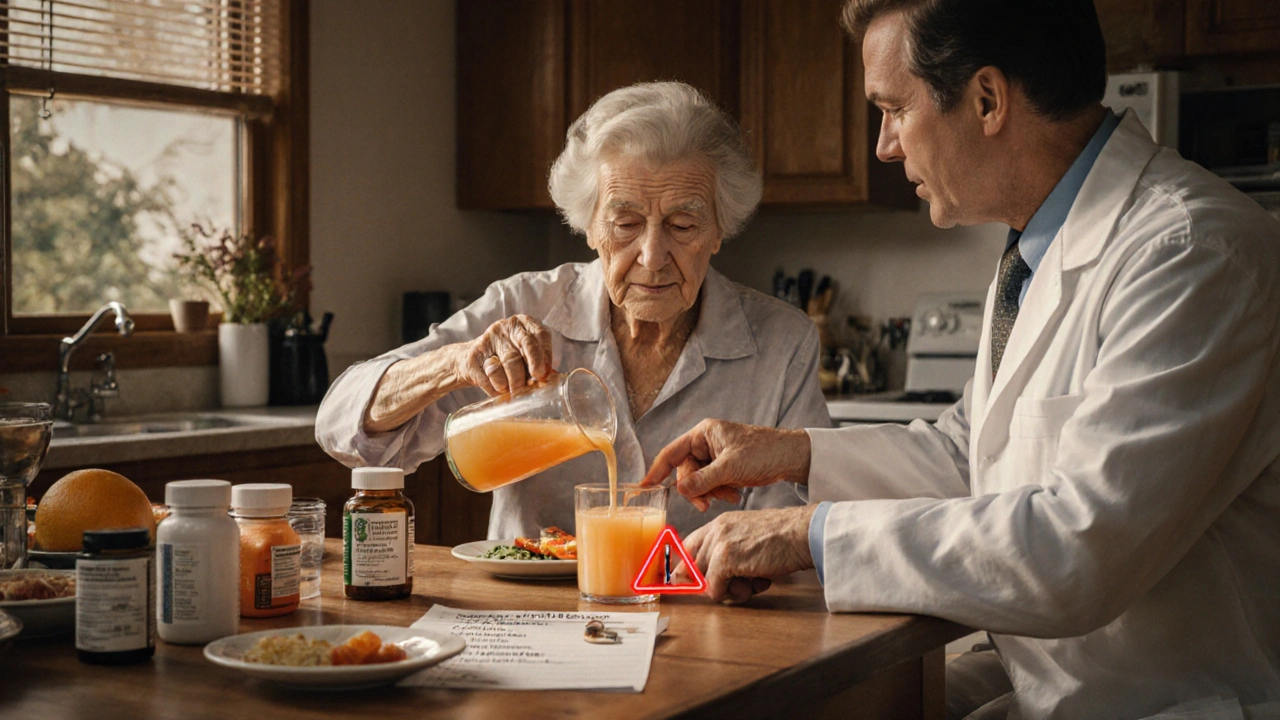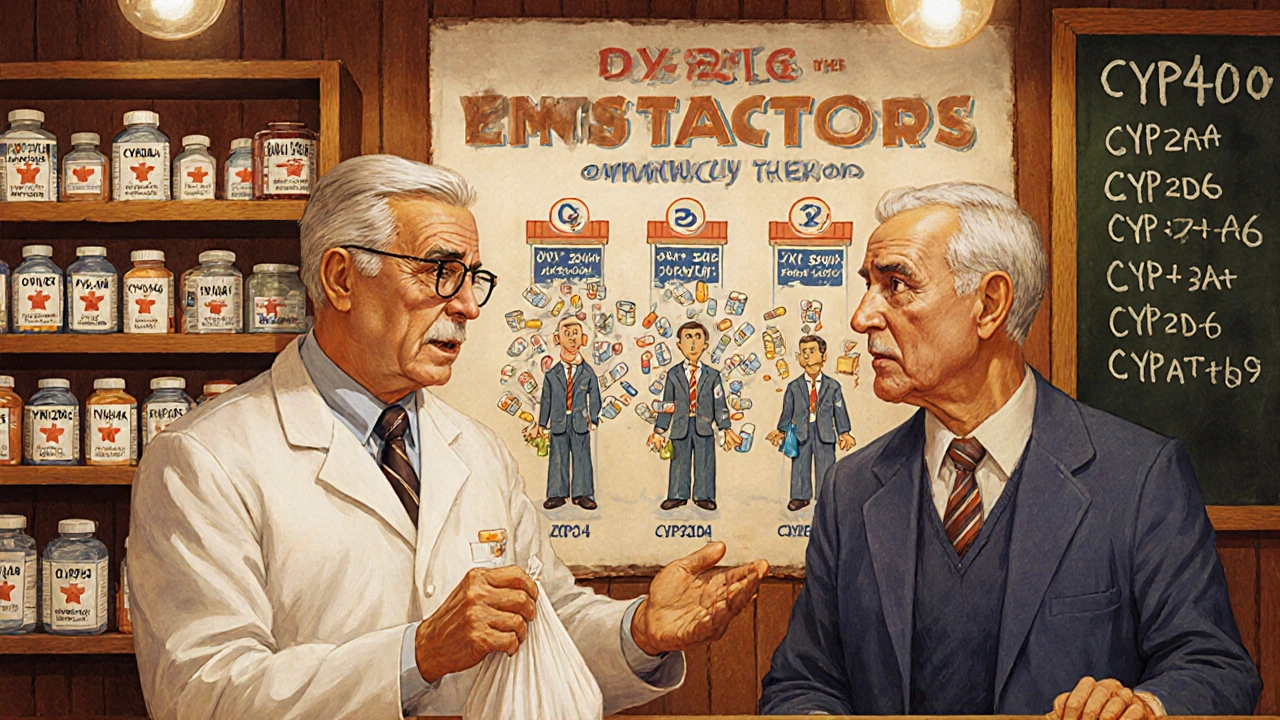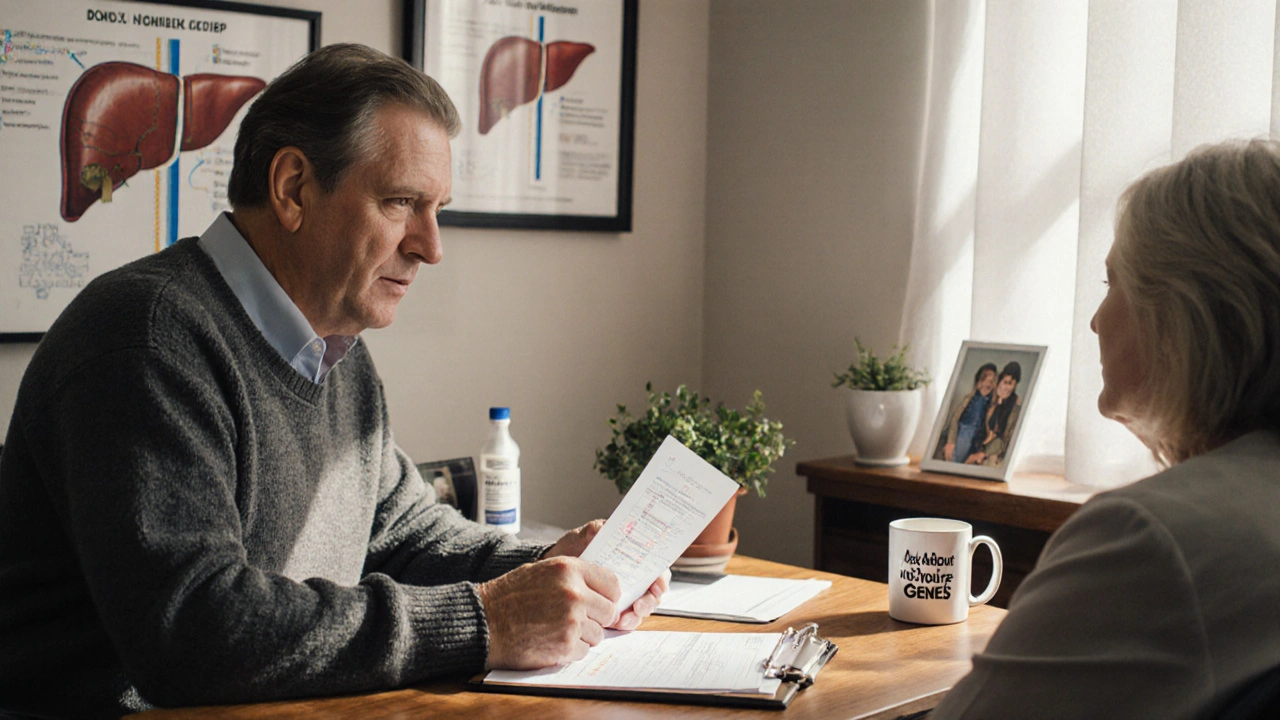CYP450 Enzyme Interactions: How Medications Compete for Metabolism
 Nov, 19 2025
Nov, 19 2025
Imagine taking your daily statin for cholesterol, then adding an antibiotic for a sinus infection - and suddenly, your muscles start aching badly. You didn’t change your dose. You didn’t overdo it. But your body is reacting like you took ten times the pill. This isn’t rare. It’s happening because two drugs are fighting for the same metabolic highway in your liver - the CYP450 enzyme system.
What Are CYP450 Enzymes, and Why Do They Matter?
CYP450 enzymes are your body’s main drug processors. Think of them as specialized workers in a factory that breaks down medications so your body can get rid of them. About 90% of all prescription drugs pass through these enzymes. The rest leave the body through urine or get processed by other, slower systems.
There are six major CYP450 enzymes that handle most of this work. CYP3A4 alone deals with half of all medications - including statins, blood thinners, and painkillers. CYP2D6 handles a quarter, especially antidepressants and beta-blockers. CYP2C9, CYP2C19, CYP1A2, and CYP2E1 split the rest. Together, they manage over 200 commonly used drugs.
These enzymes aren’t just in the liver. They’re also in your intestines, kidneys, and even the placenta. That’s why some drugs interact differently when taken with food - grapefruit juice, for example, blocks intestinal CYP3A4 and can make your blood pressure pill or cholesterol drug too strong, sometimes dangerously so.
How Do Drugs Compete for the Same Enzyme?
Think of CYP450 enzymes as busy toll booths. Each drug needs to pass through one to get broken down. If two drugs try to go through the same booth at once, one gets stuck waiting. That’s called competition - and it’s the most common type of CYP450 interaction.
When Drug A and Drug B both rely on CYP3A4, the stronger one wins. If Drug A binds to the enzyme 10 times more tightly than Drug B, it can block Drug B from being processed. That means Drug B builds up in your blood. A small dose becomes too much. For drugs with a narrow safety window - like warfarin or digoxin - that’s a recipe for hospitalization.
One real-world example: a 72-year-old woman took simvastatin (a statin) and clarithromycin (an antibiotic). Clarithromycin is a strong CYP3A4 inhibitor. Within three days, her simvastatin levels spiked tenfold. She developed rhabdomyolysis - a life-threatening muscle breakdown. This isn’t a fluke. It’s textbook CYP450 competition.
Inhibition vs. Induction: Two Opposite Problems
There are two main ways drugs mess with CYP450 enzymes: inhibition and induction.
Inhibition is when one drug slows down the enzyme. This can be quick - like when you take fluvoxamine (an antidepressant) and theophylline (a breathing medication). Fluvoxamine blocks CYP1A2. Within 48 hours, theophylline levels can jump from normal to toxic, causing seizures. This happened to a Reddit user who described their friend’s hospitalization after this combo.
Induction is the opposite. One drug tells your liver to make more enzymes. That speeds up metabolism. Rifampin, an antibiotic used for tuberculosis, can make CYP3A4 activity jump by 400-600%. If you’re on birth control, an immunosuppressant, or an antiviral, rifampin can make them useless. A patient on cyclosporine after a transplant once lost their graft because they took St. John’s wort - a herbal supplement that induces CYP3A4. The transplant drug dropped to non-therapeutic levels.
Induction takes days to show up. You won’t feel it right away. That’s why it’s sneaky. You might stop the inducing drug, but the enzyme levels stay high for weeks. Your next medication might still get broken down too fast.

Genetics Play a Bigger Role Than You Think
Not everyone processes drugs the same way. Your genes decide whether you’re a slow, normal, or super-fast metabolizer.
For CYP2D6 - the enzyme that turns codeine into morphine - about 5-10% of white people are poor metabolizers. They get no pain relief from codeine because it never turns into morphine. On the other end, 1-10% are ultrarapid metabolizers. They turn codeine into morphine so fast that they overdose on their own body’s production. There are documented cases of infants dying from breast milk if their mother is an ultrarapid metabolizer and takes codeine.
Same goes for clopidogrel (Plavix), a blood thinner. It needs CYP2C19 to activate. But 30% of Caucasians and 60% of Asians are poor metabolizers of this enzyme. They don’t get the full benefit. That’s why the FDA now recommends genetic testing before prescribing it.
These differences explain why two people on the same dose can have totally different outcomes. One gets sick. The other feels fine. It’s not about compliance. It’s about biology.
What Medications Are Most at Risk?
Not all drugs are equal when it comes to CYP450 interactions. Some are more sensitive. Here’s who’s most vulnerable:
- Narrow therapeutic index drugs: These have a tiny margin between effective and toxic. Examples: warfarin (CYP2C9), digoxin (CYP3A4), lithium (CYP2D6), phenytoin (CYP2C9).
- Prodrugs: These need CYP450 to become active. Codeine (CYP2D6), clopidogrel (CYP2C19), tamoxifen (CYP2D6). If the enzyme is blocked, the drug doesn’t work.
- Drugs with high fraction metabolized (fm ≥0.25): If more than a quarter of the drug is processed by one enzyme, even mild inhibition can cause trouble.
Common perpetrators? Antibiotics like clarithromycin and erythromycin (CYP3A4 inhibitors), antidepressants like fluoxetine and paroxetine (CYP2D6 inhibitors), and antifungals like ketoconazole (strong CYP3A4 inhibitor). Even over-the-counter meds like cimetidine (Tagamet) can interfere.
What About Herbal Supplements and Food?
Herbs aren’t safe just because they’re natural. St. John’s wort is a powerful CYP3A4 inducer. It can slash levels of birth control pills, antidepressants, and HIV meds. Garlic and green tea can inhibit CYP3A4 and CYP2C9. Turmeric? It inhibits CYP2D6 and CYP3A4.
Grapefruit juice is the classic offender. One glass can block intestinal CYP3A4 for 24 hours. It affects over 85 drugs - from cholesterol meds to anxiety pills. Orange juice? Safe. Pomelo? Just as bad as grapefruit. Don’t assume all citrus is the same.

How Do Doctors and Pharmacists Prevent This?
Good clinicians don’t guess. They check. Tools like Lexicomp and Micromedex have CYP450 interaction databases with 95% accuracy. Many hospitals now use electronic alerts in their prescribing systems. If you’re on warfarin and your doctor tries to add fluconazole, the system flashes a red warning.
Pharmacogenomic testing is becoming more common. Panels test for CYP2D6, CYP2C19, CYP2C9, and others. Costs range from $250 to $500. Turnaround is 3-7 days. It’s not routine yet - only 28% of primary care doctors order it regularly. But for patients on five or more meds, it’s a game-changer.
One nurse surveyed 1,200 colleagues. The most common interaction they saw? SSRIs (like fluoxetine) blocking CYP2D6 and raising levels of metoprolol, leading to slow heart rate. Simple fix: switch to an SSRI that doesn’t inhibit CYP2D6, like sertraline.
What Can You Do?
You don’t need to be a pharmacist to stay safe. Here’s what works:
- Always tell your doctor and pharmacist about every medication, supplement, and herb you take - even if you think it’s harmless.
- Ask: “Could this new drug interfere with anything I’m already taking?”
- Don’t start herbal supplements without checking. They’re not regulated like drugs.
- If you’re on a blood thinner, seizure med, or transplant drug, be extra cautious with new prescriptions.
- Use one pharmacy. They track everything in one place and can flag conflicts.
If you’re on multiple meds, ask about pharmacogenomic testing. It’s not magic, but it removes guesswork. For people with chronic conditions or complex regimens, it’s the closest thing to a personalized safety net.
The Future: AI and Better Tools
By 2024, 75% of major electronic health records (like Epic and Cerner) now auto-flag CYP450 interactions. IBM’s Watson for Drug Interactions can predict CYP450 conflicts with 89% accuracy. The NIH is working on standardizing gene names so results from different labs can be compared.
Still, challenges remain. Most people take 5-6 medications. That’s over 10 potential CYP450 clashes per person. And 30% of gene variants are still not fully understood. But the trend is clear: CYP450 knowledge is no longer optional. It’s part of standard care.
Medications don’t just work in isolation. They live in a crowded system - and enzymes like CYP450 are the gatekeepers. When you understand how they compete, you stop seeing drug interactions as accidents. You see them as predictable, preventable, and solvable.
What is the most common CYP450 drug interaction?
The most common clinically observed interaction is between SSRIs (like fluoxetine or paroxetine) and beta-blockers (like metoprolol). SSRIs inhibit CYP2D6, which slows the breakdown of metoprolol, leading to higher blood levels and risks like slow heart rate or low blood pressure. This happens in 15-20% of patients taking both.
Can grapefruit juice really affect my meds?
Yes. Grapefruit juice blocks CYP3A4 in the gut, which can cause drugs like simvastatin, atorvastatin, felodipine, or cyclosporine to build up to dangerous levels. One glass can have an effect for up to 24 hours. Other citrus fruits like pomelo do the same. Orange and lemon juice are safe.
Why does my doctor test my genes for some meds?
For drugs like clopidogrel, codeine, or certain antidepressants, your genes determine if the drug will work at all. If you’re a poor metabolizer of CYP2C19 or CYP2D6, standard doses may be useless or even harmful. Genetic testing helps tailor the dose or choose a better drug from the start.
Are herbal supplements safe with my prescriptions?
No, not without checking. St. John’s wort induces CYP3A4 and can make birth control, antidepressants, and transplant drugs fail. Turmeric, garlic, and green tea can also interfere with CYP enzymes. Always tell your pharmacist about every supplement you take.
How long does it take for a CYP450 interaction to show up?
Inhibition (blocking) can happen within hours to days - like when you add an antibiotic and your statin levels rise. Induction (speeding up metabolism) takes longer - 3 to 14 days - because your body has to make more enzyme. Effects can last weeks after stopping the inducing drug.
Is pharmacogenomic testing worth it?
If you take five or more medications, have had unexplained side effects, or are on a drug like clopidogrel, warfarin, or a psychiatric medication - yes. It can prevent hospitalizations and help find the right dose faster. Costs are $250-$500, and results come in 3-7 days. Many insurance plans cover it for high-risk patients.

swatantra kumar
November 20, 2025 AT 07:07Bro this is wild 😱 I took clarithromycin last year with my statin and felt like my legs were turning to jelly. Thought I was dying. Turns out I was just a walking CYP3A4 traffic jam. Pharma needs to put warning labels on antibiotics like they do on cigarettes.
Dave Wooldridge
November 21, 2025 AT 14:10They don't want you to know this. The FDA, Big Pharma, and your doctor are all in on it. CYP450? More like CYP-CONTROL. They design drugs to interact so you need MORE meds to fix the side effects. It's a pyramid scheme disguised as medicine. I've seen the documents. They're laughing all the way to the bank while you're in the ER with rhabdo.
robert cardy solano
November 23, 2025 AT 02:09Had a friend on warfarin get prescribed fluconazole. INR spiked to 8. She almost bled out. No one asked about her meds. Just assumed she was 'non-compliant'.
Turns out, she took exactly what she was told. The system failed her. Not her.
Now she only uses one pharmacy and refuses to take anything new without a pharmacist review. Smart woman.
serge jane
November 24, 2025 AT 22:39It's fascinating how biology doesn't care about our convenience. We take drugs like they're candy and expect perfect outcomes. But enzymes don't negotiate. They don't have empathy. They just do their job. And when two molecules collide in a crowded active site? There's no winner. Just chaos.
Maybe we're not meant to take so many pills. Maybe the real solution isn't more science but less intervention. We treat symptoms like enemies instead of signals. The body isn't broken. It's trying to survive our choices.
Nick Naylor
November 25, 2025 AT 15:49Brianna Groleau
November 27, 2025 AT 12:37I work in a rural clinic and this hits home every week. An elderly lady came in with muscle pain after starting a new antibiotic. She didn't know it could interact with her cholesterol pill. She thought 'natural' meant safe. I showed her the grapefruit juice warning on her bottle - she hadn't even read it.
Now I print out simple one-page handouts for every new med. No jargon. Just: 'Don't mix this with this. Don't drink this juice. Tell your pharmacist everything.'
It's not glamorous. But it saves lives. And honestly? That's the real healthcare.
Rusty Thomas
November 29, 2025 AT 07:57OMG I JUST REALIZED WHY I WAS SO SICK LAST YEAR 😭 I was on sertraline and metoprolol. My heart felt like it was stuck in molasses. My doctor said I was 'anxious' and upped my antidepressant. I almost quit my job because I thought I was losing my mind.
Turns out? CYP2D6 inhibition. Sertraline is fine. But paroxetine? NOPE. Switched to citalopram. Now I can run 5K without feeling like I'm about to pass out. Why didn't anyone tell me?!!
Also - St. John’s wort? I tried it for 'mood'. Ended up getting pregnant while on birth control. 🤦♀️
Lesson learned: if it's in a bottle and says 'natural', it's probably trying to kill you.
Sarah Swiatek
November 30, 2025 AT 01:04People think pharmacists are just pill dispensers. They’re not. They’re the last line of defense. I once caught a lethal combo: clopidogrel + omeprazole. Omeprazole blocks CYP2C19 - so clopidogrel couldn't activate. Patient was at risk for a heart attack. I called the doctor. He said 'Oh, I didn't know that.'
So I emailed him three studies. He changed it. The patient thanked me. No fanfare. No glory. Just a quiet win.
That’s the job. Not the drugs. Not the tech. The human who checks.
Also - yes, turmeric interferes. I’ve seen it. And no, your 'herbal tea' isn't innocent. It’s a biochemical grenade.
Rebecca Cosenza
December 1, 2025 AT 01:23You shouldn't be taking 5 meds. You should be eating real food, sleeping, and moving. This whole system is a scam. You're being turned into a walking pharmacy. Take responsibility. Stop blaming enzymes. Stop blaming doctors. You chose this.
Pawan Jamwal
December 1, 2025 AT 16:34India has better drug safety than the US. We don't allow OTC sales of CYP3A4 inhibitors without prescription. We have strict labeling. And we know our population has high CYP2C19 poor metabolizer rates - so we adjust dosing from day one. Why does America act like genetics is a luxury? We're not dumb. We know how to do this.
Bill Camp
December 2, 2025 AT 15:08Look, if you can't handle your own body, don't take meds. I'm a veteran. I've been on 12 different prescriptions at once. I know what happens when you mix stuff. You don't need a PhD to read a label. You need discipline. And if you're too lazy to ask your pharmacist? Then you deserve the side effects.
Lemmy Coco
December 3, 2025 AT 00:05hey so i was just reading this and i think i might have had a cyp interaction last month? i took fluoxetine and then started taking that melatonin gummy with turmeric in it? and then my head felt weird and i was super tired? i didn't think it was related but now i'm kinda worried? idk if anyone else has had this? i just use one pharmacy but they never ask about supplements lol
rob lafata
December 3, 2025 AT 19:01You people are naive. This isn't 'interaction'. It's planned obsolescence. The entire pharmacological industry is built on creating cascading side effects so you need more drugs. CYP450? More like CYP-CONTROL-450. They don't want you cured. They want you dependent. Look at the profit margins on statins + anticoagulants + antidepressants. It's a golden triangle of chronicity. And now they're selling you genetic tests to make you feel like you're 'in control' while they keep cashing checks. Wake up. This isn't science. It's capitalism with a stethoscope.
Matthew McCraney
December 4, 2025 AT 00:02I knew this was a government cover-up. The CDC knows about CYP450 interactions. They've known since 2007. But they won't tell you because if you realized how many drugs are poison when mixed, you'd riot. They're feeding us slow-acting toxins and calling it 'healthcare'. I stopped all meds. Started juicing. Now I'm 100% better. The system hates people like me. They call me 'anti-vax'. I call myself 'anti-bullshit'.
And grapefruit? That's just the tip. They put the warning on the bottle so you think you're safe. But the real danger? The combo of three pills you didn't even know were interacting. That's the silent killer. And they're laughing.